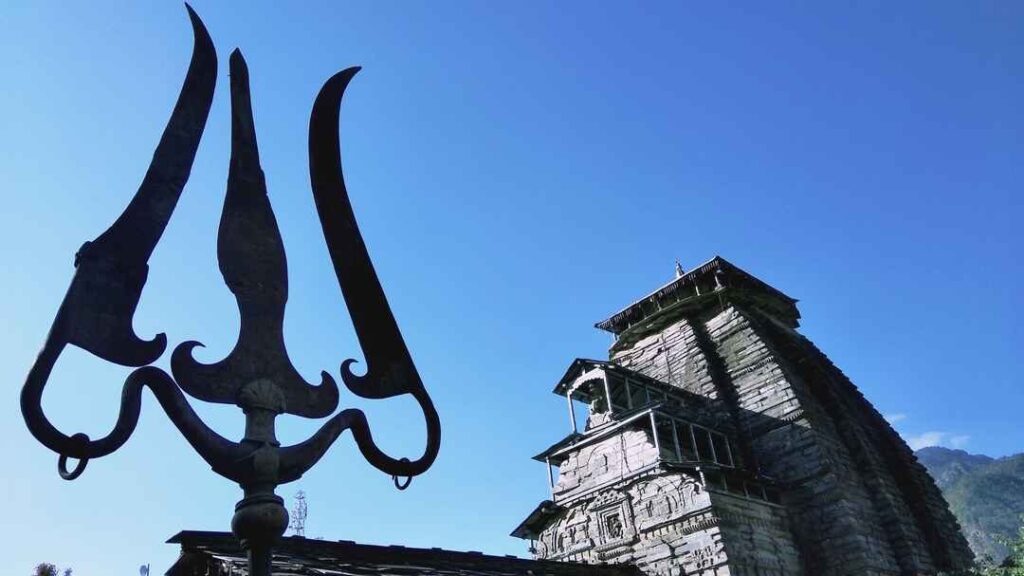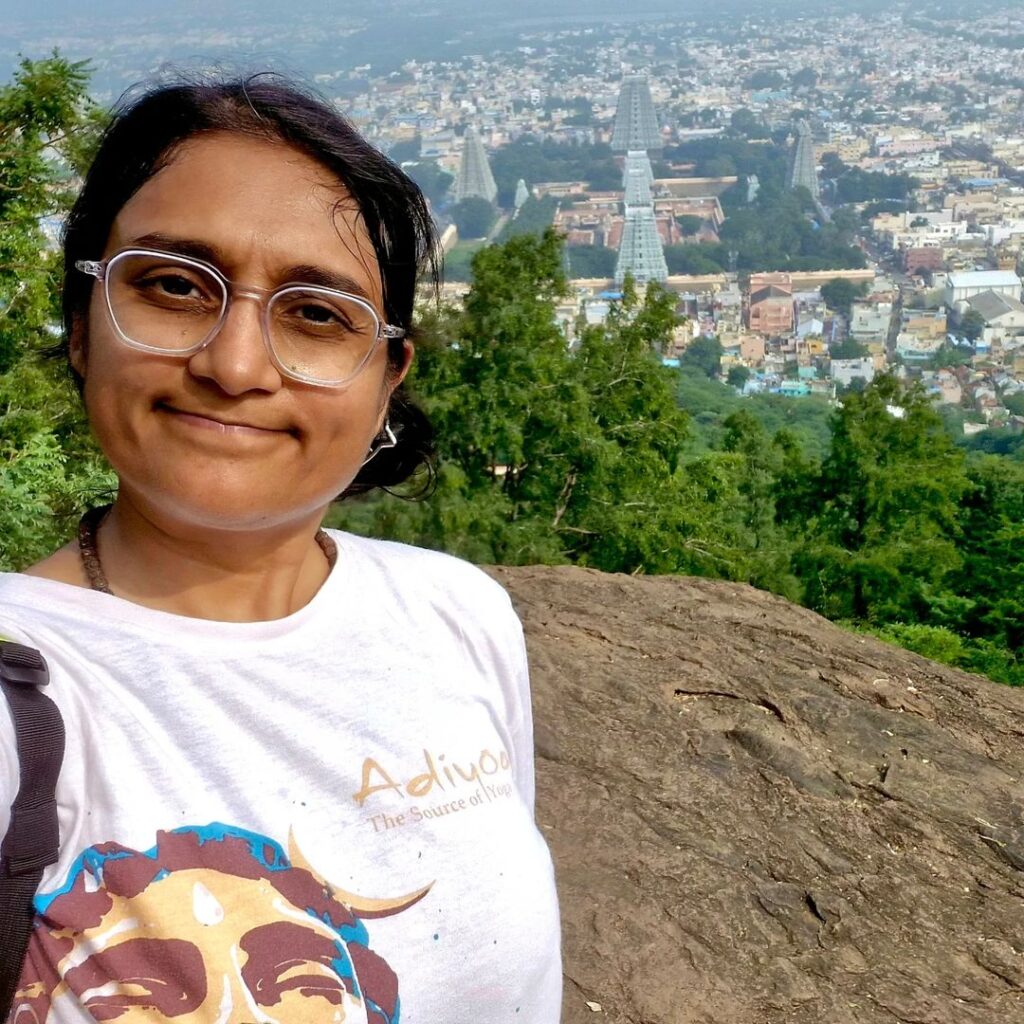
Sadhguru’s Bangalore ashram has a dedicated shrine for a 54-feet Trishula. It is unique and one of the first such shrines that Sadhguru has set up. It got me thinking about the various giant Trishula’s that we have scattered across India.
In Sadhguru’s Coimbatore ashram, there is a giant trishula as part of the Linga Bhairavi Devi temple. That Trishula is tilted towards the left by 11 degrees. As this is the Devi trishula, Sadhguru has said that 11 is significant for Devi. Moreover, the left tilt symbolizes the feminine aspect. Devotees can tie sacred threads onto this Trishula as part of their offerings.
Here in the Bangalore ashram, the giant Trishula or “Mahashula” as Sadhguru has called it, rises straight up. On the door of this shrine, the following mantra is carved out,
Yog Yog Yogeshwaraya
Bhoot Bhoot Bhooteshwaraya
Kaal Kaal Kaaleshwaraya
Shiva Shiva Sarveshwaraya
Shambho Shambho Mahadevaya
This is the mantra associated with the Yogeshwar Linga temple situated below the 112 ft Adiyogi Shiva Statue. Thus, I think this Mahashula is Shiva’s trident. It is located right next to the Naga Mandapam temple, the kshetrapal of the Bangalore ashram
While a lot of Hindu temples have large Trishulas either standing independently or along with a Shiva murti, not many of them are actual shrines where devotees make offerings. Often they are decorative in nature rather than consecrated.
When I think about other devotional Trishula shrines across India one of the first few names that come to mind are all in the Himalayan belt.
Himalayan Larger than Life Trishulas
Shakti Trishula, Uttarkashi

Uttarkashi is the first name that comes to my mind. The Shakti trishula next to the Kashi Vishwanath temple of Uttarkashi is probably one of the most popular ones. This is a unique trishula that will not budge a micro centimetre if someone applies force on it. On the other hand, with a light touch, it moves easily. The pujari will wisely comment “Devi is also like that, be with her gently. If you get forceful, she will not yield”
This is a powerful shrine where the trishula is representation of the Devi. In fact, as per legend it is said that Durga devi took the form of this Trishula after killing Mahishasura. While we may not know the exact creation story for it, devotees make many offerings to this Trishula. The shrine is maintained by a dedicated pujari. There is an akhand diya maintained in a corner.
This trishula is 6 metres high above ground, however, it is not known how deep down it goes. So, quite a mysterious place indeed!
Shiva’s Trishula, Gopeshwar Dham

The story of Shiva opening his third eye and burning Kama dev to ashes is a common story. In Gopeshwar Dham there is another version of this story, Shiva throws his Trishula at Kama dev to annihilate him and this Trishula is found here in Gopeshwar Dham. It is about 5 metres high and made from ashta dhatu (eight metals). This trishula is a treasured relic here as it is considered Shiva’s own.
Online reviews suggest a similar dynamic where the trishula won’t budge if it is touched with force. But if we touch only one finger to it, it vibrates. I wonder whether this is then a fallout of the metallurgical processes used to make these trishulas at that time. Or whether this message of using a gentle touch was commonplace in ancient times and thus different ancient temples are promoting it in this manner.
Devotees to the Prayagraj Kumbh Mela also had the chance to see one of the tallest Trishula’s in the world – 151 ft – at the Mauj Giri ashram of Juna Akhada in Kidganj.
Symbolism of the Trishula
While I knew that the trishula was the symbol of the three gunas – tamas, rajas, sattva or the three nadis in the body – ida, pingala, sushumna. However, I thought it was also a weapon. It came as a surprise to me that it is not a very good weapon.
Sadhguru recently said, “It’s quite a lousy weapon if you want a weapon.Trishula is not a weapon, it is a symbolism. It is to show you, on the surface it is three, deep down it is one.”
I researched some of the history of the trident. Considering that it is seen in western history also with Poseidon, Neptune and other sea-faring Gods using it. One of the main uses of a trident was actually for fishing or other such occupational activities.
Its use in military conflicts was highly limited. A particular group of gladiators used a trident with a fishing net as their fighting technique, however, they were one of the least respected groups. And even considered effeminate.
In Korea there is a trident-like weapon called Dangpa. However, the two side prongs are usually a lot shorter. So, it is more like a spear.
One thing we can be sure of however is that the Trishula is a very ancient symbol and iconography. “The linga and the trishula (trident) are both present, though rare so far, in Harappan culture” says padmashree recipient Michel Danino. As per other sources, the well-known pashupati image from the Harappan civilization wears a three pronged crown. This is being considered as one of the earlier depictions of the Trishula or basically mastery over three fundamental aspects of life.
All in all, I am happy to have a Trishula shrine here in the Bangalore ashram to meditate in. Looking forward to the upcoming consecrations by Sadhguru.

Priyanka Dalal is a prolific writer, traveller and yoga practitioner from 20+ years. She is a student of Ayurveda and has written for many publications like OpenMag, Swarajya, Deccan Herald, Outlook Traveller and more. Currently, she is volunteering at Sadhguru Bangalore ashram. Follow her on YouTube channel @InSpirituality
